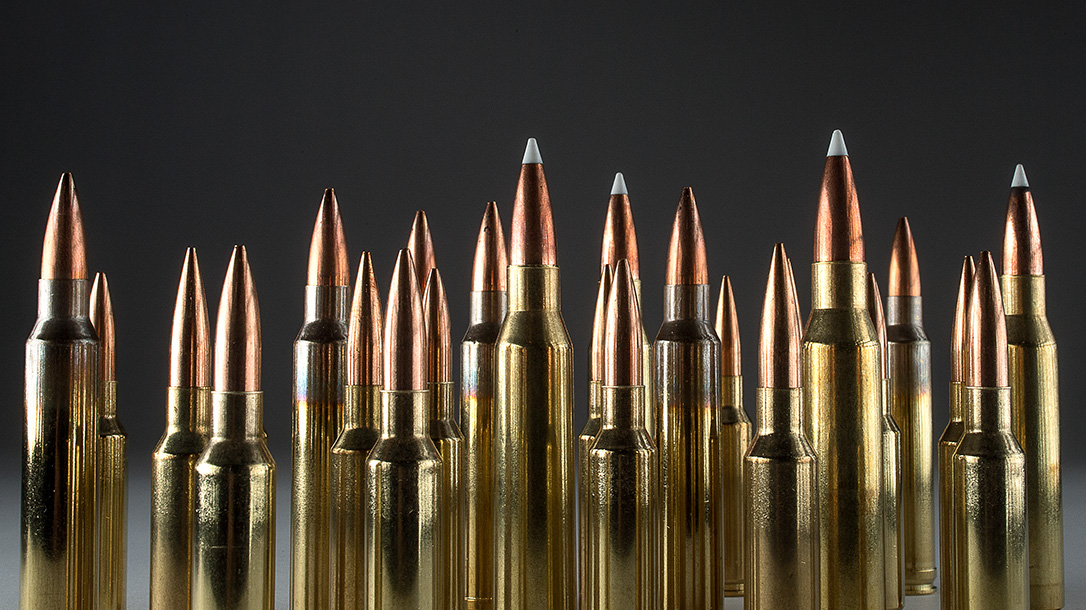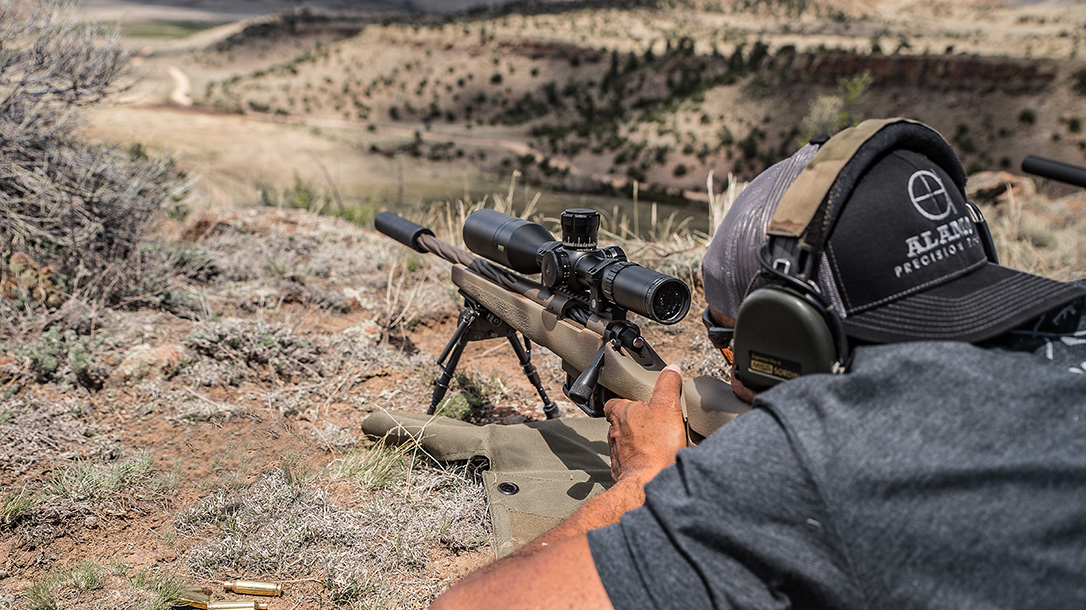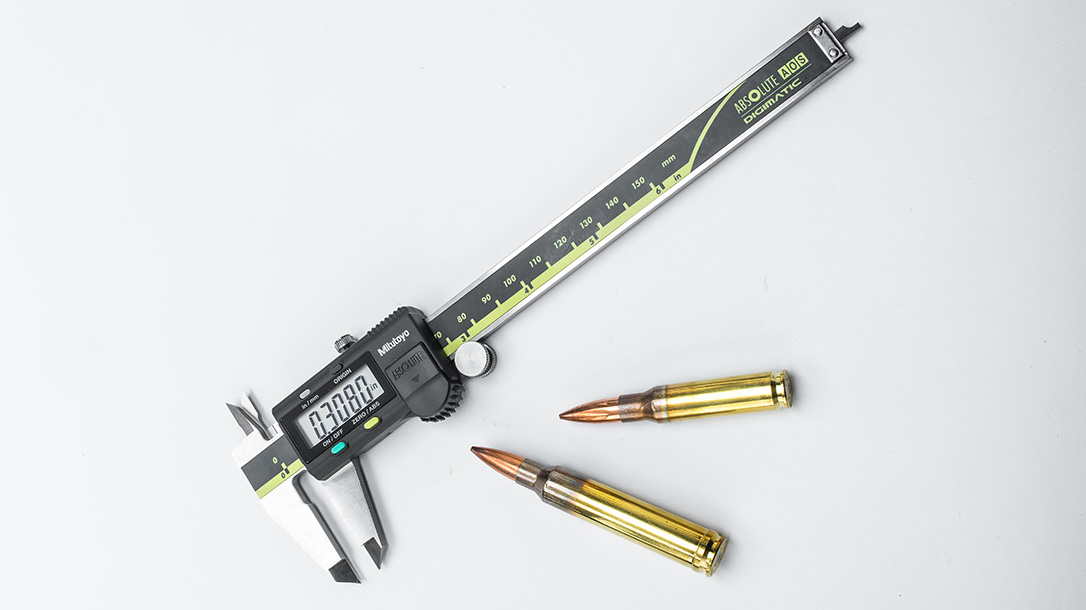What are the best rifle calibers for long-range shooting? Is there a single best option? This topic has been argued to dust in print and electronic formats for over 100 years. So, we aren’t going to answer that question. Instead, we are going to present a methodology for you to intelligently answer the question for yourself.
The topic of caliber selection takes on various forms, but here are a few factors worth considering that consistently come up in the discussion:
Advertisement — Continue Reading Below
• Will you reload or shoot factory ammunition?
• Is the caliber well supported for reloading?
• Is this going to be specifically for targets or hunting?
• Is barrel life a consideration?
• What is your budget for not only the rifle, but also ammunition?
Some Definitions
As you can see, this seemingly simple question is a minefield that can lead shooters astray. But we’re here to help.
Advertisement — Continue Reading Below
First, we must define a few terms. Oftentimes “caliber” is used interchangeably for both the bullet diameter in question and the actual round being fired. This is confusing. Therefore, the bullet diameter will be referred to as “caliber” in this article. “Chambering” will be used to define the shape of the body of the cartridge, capacity, etc.
For the sake of clarity, in this article we’re going to ignore wildcats entirely. The same process works for wildcats, but the additional questions of brass forming, equipment and knowledge of the shooter/reloader comes into question, and that can complicate the approach significantly.
We also need to define the path or we will veer aimlessly off course. I have been known to ask people a simple question: “What is this rifle going to be used for 80 percent of the time? How about 95 percent of the time?” The goal of this question is to get someone thinking, “Am I really going to do this?”
Advertisement — Continue Reading Below
The Selection Process
Step 1: Lay out a set of goals for the rifle platform as a whole. What are the intended targets? Is impact energy/momentum a requirement, or is just hitting acceptable? What about weight? Is there a weight limit on the complete rifle either imposed by rules or by sensibility afield? Is there a limitation on the use of muzzle devices for recoil and noise attenuation?
Step 2: Will factory ammunition be paramount to the use of the rifle? If reloading is going to happen, are you currently an experienced reloader or do you need to learn this as well? Does the factory ammunition fall within your budget so you can practice and garner appropriate skill with the rifle to use it effectively?
Advertisement — Continue Reading Below
Step 3: Is the caliber one that has good support for reloading components or ammunition? In other words, will you be able to “feed the beast”?
Step 4: Does a rifle in this caliber need to be custom built? And is the cost of that custom work within the budget of the project?
Step 5: Summarize rifle calibers that fit the criteria in Steps 1 through 4 into a concise list.
Advertisement — Continue Reading Below
Step 6: Try to streamline the list in Step 5 by cutting duplicate performance calibers and focusing on no more than three calibers within a
specified bore (caliber) size.
Step 7: Use Steps 1 through 4 to generate the questions as the rating criteria against which the streamlined list of Step 6 will be further cut.
Now consider what your rifle needs. Don’t make it too complicated. Shooters often try to do too much with a single platform. For instance, it’s certainly functional to shoot steel plates, prairie dogs and moose with the same 7mm Rem Mag. The rifle that is designed to shoot F-Class and steel plates, however, tends to not be well laid out for hiking the western U.S. in pursuit of big game. Likewise, taking a lightweight rifle that is laid out to hunt is not going to be generally well suited to a 100-plus-round day at the range. A solid approach to structure the rifle’s needs is laid out along these lines:
Advertisement — Continue Reading Below
- What will this rifle do 75 percent of the time?
- What about another 15 percent of the time?
- And what about 5 percent of the time?
You have now defined what the rifle is going to be used for 95 percent of the time. If the answers above are …
- Shooting paper and steel at the range, inside of 1,000 yards
- Practicing stages and skills, generally inside 1,000 yards
- Shooting matches, most shots within 1,000 yards
Then the aforementioned lightweight rifle is ill suited to these tasks, with its light barrel and lightweight stock. While it may seem comedic to make such a proposal, it’s more common than you would think in my experience. People often want a new rifle that they can use for everything, but the requirements for hunting western game are outlandishly unbalanced with the rest of the needs of that rifle platform. This user has not realistically narrowed down their requirements, or they’re not being honest with themselves about how the rifle is actually going to be used.
Advertisement — Continue Reading Below
Here’s an example: A shooter wants a rifle built. The caliber choices that they have come down to are pretty broadly spaced: the 6.5 Creedmoor and .300 Win Mag. There’s a large difference between those two calibers, and there are a lot of choices in between that perform somewhere in the middle. This shooter is someone who has made the realization that not every caliber works for everything, but they have not properly assigned a priority to their requirements. Is the right approach a different caliber, like the 6.5mm SAUM? Or is the right choice actually one of the two chamberings suggested initially? Let’s begin by setting up a description of the uses. From there we can work to a list of requirements and potential candidates.
- Long-range target shooting, time at the range, maybe the occasional low-key competition but pretty much just fun shooting.
- Target shooting distances from point blank to 1,200-ish yards.
- Some hunting use, maybe as large as western mule deer or elk, but primarily East Coast and Midwest whitetails.
- Hunting shots will probably occur between 300 and 650 yards.
- We won’t be carrying the rifle a lot, but it will get carried for more than from the vehicle to the firing line and back.
- Precision and accuracy are paramount.
- The recoil should be relatively low, balancing with the weight of the rifle for overall shootability at the range and the field.
- The muzzle should be threaded so that a suppressor and/or brake can be employed.
- Factory ammunition should be prevalent for easy access during a hunting trip.
This set of uses has given a pretty good definition of a common long-range, dual-purpose rifle. This is sort of like a Goldilocks and the three Bears analogy—the rifle is not too heavy, nor too light. Not too much recoil, nor too little energy. It’s a balanced rifle that can do a few things very well. First, we will put together a list of potential rifle calibers and chamberings that meet the ammunition requirement, as there is little purpose in having a caliber that would immediately violate a project boundary.
For the sake of simplicity, we will look to only a few factory chamberings that are readily available across North America. This is far from an exhaustive list but we need to draw a line somewhere, so we will keep it to about 10 chamberings total.
Advertisement — Continue Reading Below
- 6mm/.24 caliber: .243 Win, 6mm Creedmoor
- 6.5mm/.26 caliber: .260 Rem, 6.5 Creedmoor, 6.5x47mm Lapua
- 7mm/.28 caliber: 7mm-08 Win, 7mm Rem Mag
- .30 caliber: .308 Win, .30-06 Springfield, .300 Win Mag
The Rifle’s Layout
Let’s keep the caliber list (see bottom of this article) available while we discuss the rifle’s layout. The recoil should be kept low, balancing with the overall weight of the rifle and keeping shootability at the range and in the field in mind. So we need to assign a target weight for the rifle and scope together.
Based on my personal hunting experience and the feedback I get from customers with completed rifles, the target weight for the above description is about 13 to 14 pounds for a complete rifle (not including a bipod). The typical precision rifle optic and rings are going to run around 2 pounds on their own, so we have a bare rifle weight that’s hovering around 10.5 to 12 pounds.
Now we have some numbers to flesh out the recoil question. To keep the calculations shorter, we will just run one rifle weight at the average of the target band: 11.25 pounds for a total weight of 13 pounds. We are going to use a free calculator platform that is graciously hosted by JBM Online at jbmballistics.com. The page has a multitude of highly useful calculators and information on it, so take some time to explore the page a little. I strongly suggest bookmarking it for future reference.
The 6mm and 6.5mm cartridges are all low-recoil, high-ballistic-efficiency cartridges. The 7mm offerings start to bring more recoil, and the .30 calibers are generally where most shooters consider recoil to be “medium to heavy.” We’ll say that low/light recoil is less than 8 foot-pounds; medium recoil is between 8 and 12.5 foot-pounds and heavy recoil is over 12.5 foot-pounds.
The calculator doesn’t account for the effects of muzzle brakes or suppressors in cutting recoil. Keep in mind that the recoil numbers below are based on approximations of the factory-published velocities and approximate powder charges used in the rifle calibers to attain those velocities. We won’t spend time delving into what might happen from tailoring loads, powders, etc.
Now that we have some idea what the recoil levels will be, we can also look at the ballistics. Since trajectories are easy to calculate, and terminal ballistics is a rabbit hole unto itself, we will skip the terminal ballistics entirely and just skim the trajectories.
- Any of the chambering and calibers above can readily harvest North American big game with proper shot placement. All of them are fully capable of making shots on steel and paper targets at distances up to and beyond 1,200 yards.
- As far as weight goes, all of them can make the weight requirement in the rifle platform.
- All of them can be extremely repeatable on target.
- All of them are straightforward to handload, and most have good factory offerings.
The 6mm and 6.5mm offerings are good examples of chamberings with excellent ammunition and component availability. The .243 Winchester, 6mm Creedmoor and 6mm XC are all very similar in performance. They all shoot a 105- to 110-grain match bullet around 3,000 to 3,100 fps, with very light recoil and super-flat/straight trajectories. In the U.S., there are lots of hunting options for the .243, and the 6mm Creedmoor is quickly catching up in that regard. If you might need to walk into a hunting shop or hardware store, the 6mm XC makes little sense.
In the 6.5mm options, we have a similar situation with the .260 Remington, 6.5 Creedmoor and 6.5x47mm Lapua. The Lapua is super accurate and easy to reload. It’s a bit slower than the .260 and 6.5 Creedmoor, but it’s still certainly capable of driving 123- to 140-grain bullets fast enough to engage targets, shoot in competitions and cleanly harvest big game in North America. But factory- loaded ammo is rare and expensive, so we will cut that chambering.
The 6.5 Creedmoor and .260 Rem perform identically. Top-grade reloading components are available for both, and the speed attainable with each is essentially the same. Both are superbly accurate and easy to load for.
The .260 Remington was once the dominant 6.5mm cartridge in competition circles. However, factory ammo and rifle offerings were slim and carried high prices.
The 6.5 Creedmoor, on the other hand, has spent the last 10 years closing the popularity gap on not only the .260 Remington, but also the venerable .308 Winchester. Factory ammo is available from half a dozen manufacturers. It is popular enough that this relatively new cartridge is found in small gun shops across the country.
My recent trips to Montana, Colorado and Wyoming for rifle matches and a hunting trip gave the opportunity to walk into a couple of hardware stores, gun shops and bigger retailers. Almost every one had at least one flavor of 6.5 Creedmoor available. Most of them had several choices.
These comparisons work for the 7mm-08 and 7mm Rem Mag, and the .308 versus .30-06 and the .300 Win Mag. The balancing factors dictated above are simply applied and the chamberings that pass each requirement come to the final list. We can skip through the rest and cut to the final three: the .243 Winchester, 6.5 Creedmoor and .308 Winchester. So, among these, is there an obvious choice?
Making The Cut
For target use and very little hunting, the .243 Winchester and 6.5 Creedmoor have some serious advantages over the .308 and the other .30-caliber choices we already ruled out. The .243 is not as widely used in competitions because of its propensity for a shorter barrel life. However, the 6.5 Creedmoor is highly competitive and widely used.
Armchair ballisticians might have more than a few negative things to say about the .308’s capabilities, but there is hard evidence to demonstrate that it is a highly effective cartridge. The .308’s biggest shining feature, outside of the obvious military applications, is that, while it doesn’t do any single thing the best, it does an awful lot of things very well. That gives it a near-unique status in long-range precision shooting. There are pros and cons to both. My personal choice is the 6.5 Creedmoor, but the .308 is far from being the “wrong answer.”
Perhaps cartridge choice is less important than it is continually made to be by sales and print articles? Instead, the more appropriate question may be, “What can I do with the rifle that is chambered in a cartridge I already have?” Answering that fully is probably a good topic for a book of some length, but the short answer to that question is “a lot.”
Specifications: Long Range Rifle Calibers
| Chambering | Bullet | Velocity | Recoil Energy |
|---|---|---|---|
| .243 Win | Win 87 V-MAX | 3,240 | 5.5 |
| .243 Win | 108 ELD Match | 2,990 | 6.5 |
| 6mm Creedmoor | 103 ELD-X | 3,050 | 6.3 |
| 6mm Creedmoor | 108 ELD Match | 2,960 | 6.4 |
| 6mm XC | 105 VLD | 2,950 | 6.2 |
| .260 Remington | 130 Prime | 2,900 | 8.0 |
| 6.5 Creedmoor | 130 Prime | 2,920 | 8.1 |
| 6.5 Creedmoor | 143 ELD-X | 2,700 | 8.2 |
| 6.5×47 Lapua | 136 Scenar-L | 2,785 | 7.6 |
| 7mm-08 Win | 150 ELD-X | 2,770 | 9.1 |
| 7mm Rem Mag | 162 ELD-X | 2,940 | 14.9 |
| .308 Win | 178 ELD Match | 2,775 | 11.7 |
| .308 Win | 175 Prime | 2,690 | 11.0 |
| .30-06 Springfield | 178 ELD-X | 2,850 | 15.0 |
| .300 Win Mag | 200 ELD-X | 2,850 | 20.1 |
This article is from the 2018 issue of Ballistic Precision. To subscribe or purchase individual copies, please visit OutdoorGroupStore.com.


























